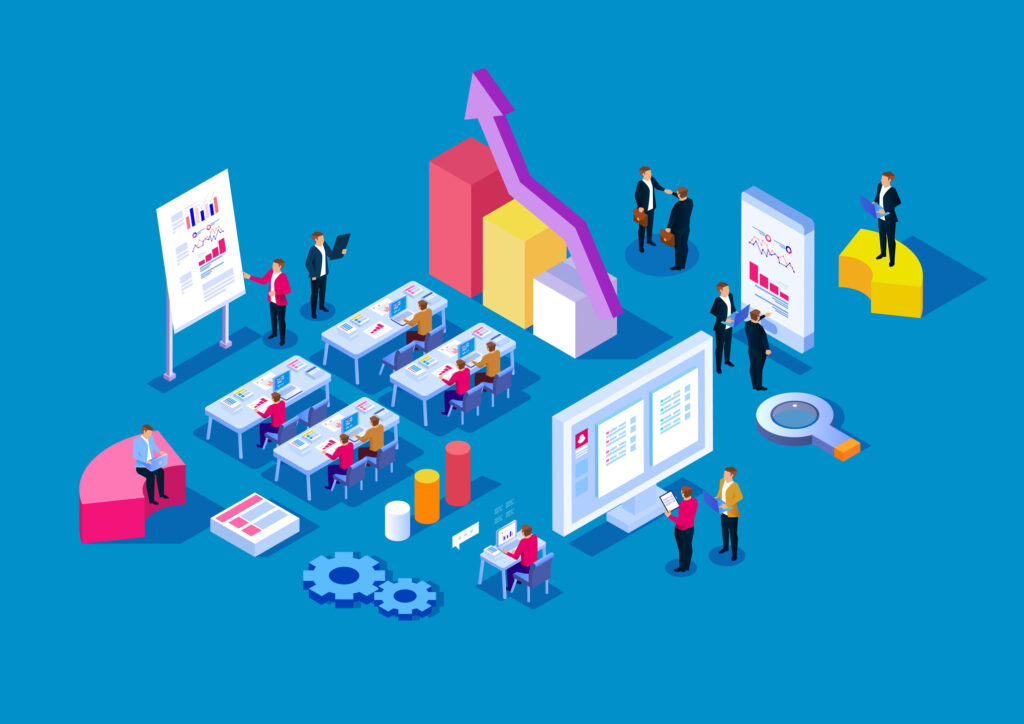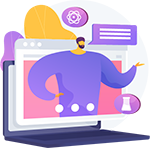Are you new to the world of enterprise Learning Management System (LMS)? Shifting from in-person or classroom training to online learning?
Being one of the essential tools for online learning, an LMS needs to be well understood to fully take advantage of it.

Who Can Benefit from an Enterprise Learning Management System?
From registration to tracking learner progress and analyzing the performance, an LMS manages everything in the learning workflow. This helps learners find and consume learning resources, learn new skills, and gain knowledge. It helps your organization identify and fill skill gaps to align with your business goals.
An LMS can be used by many types of organizations:
- Training and Education Institutions
- Entrepreneurs Building an Education Online Business
- Government, Trade Association, and Non-profit
- Corporations Focusing on Employee Skill Development, Customer or Partner Education, or Custom LMS Solutions.
Training and Education Institutions Offering Online Courses
Online learning has been a growing trend for the past decade. The 2020 pandemic has further contributed to its wider adoption and success.
By making the most of an LMS, you can open doors to engage with your learners (business customers and consumers) across the globe to grow your reach. There are no geographical boundaries in online learning.
An LMS allows you to deliver courses and learning resources in many formats, from micro learning, videos, and assessments to virtual classrooms and more.
That means your customers and students enjoy the flexibility while learning online.
‘Virtual classrooms’ combined with ‘easy-to-access’ self-paced eLearning content, is a blended learning approach that is perfect for any student no matter their location or learning needs.
Besides, it does not matter who you are training – students of any age or level, online learning facilitated through the use of an LMS provides the flexibility to meet your students’ needs.
Through an LMS, training and education institutions can offer an entire curriculum, including certifications, professional credits or licensure, or online degrees.
Your faculty or instructors can simultaneously teach various courses online. They can administer assignments or online tests, assign grades, and support the enrolled students through the LMS web portal.
Offering quality online education through an enterprise learning management system enhances brand awareness and increases revenue.
Entrepreneurs Building Education Business Online
Are you an expert in specific domain knowledge or an entrepreneur who wishes to sell online education services and products?
No matter your company size and objective, you can utilize an LMS to launch and grow your business.
An LMS lets you build and manage online courses around your expertise. You can even build an online learning community within your LMS web portal. The community is complete with online discussions, surveys, connections, and knowledge sharing among your learners and peers. This is your social learning community.
As an expert, think of an LMS as the foundation for your online and offline business. Offer your knowledge and expertise anywhere and on any venue with your learners.
It is extremely important for an LMS to include robust eCommerce capability.
Learning management systems are the nucleus for managing the learning resource catalog, all course transactions, recurring membership subscriptions, coupons or discounts, and business record keeping.
An LMS lets you reach your audience through email and mobile notifications, reminders, and messaging to keep your learning offerings in front of them.
Engaged learners are more motivated to complete their courses and reach their goals. Your leaners will appreciate their ability to interact with instructors and peers.
Government, Trade Association, Non-profits
Governments, trade associations, and non-profit organizations can take advantage of an LMS to train and educate their employees, members, and constituencies. Governments can use the same LMS for both internal and external use. While government needs employee training, they also have a somewhat unique mission to keep their citizens knowledgeable and up to date with their skills and employability. The flexibility an LMS provides makes for a better user experience, learning, and skill development.
Trade associations and non-profit organizations also have internal and external needs. Trade associations often offer conferences to their members. Even before the pandemic, the trend to offer services online had tremendous growth. Use the LMS to manage all events, onsite or virtual. Use the power of the LMS to integrate course catalogs and eCommerce.
Corporations Focusing on Employee Skill Development or Customer and Partner Education
An LMS enables you to manage many forms of learning including classroom, online, or blended. An LMS can help personalize the learning plans for individuals in a scalable manner.
An LMS brings a new level of sophistication and ‘new technology adoption’. Integration with disparate systems throughout the enterprise using a variety of training media brings an increased level of professionalism and productivity to your learning organization.
Corporations can utilize an LMS in many different ways to meet the learning needs of their extended enterprise – employees, customers, and channel partners:
Employee Skill Development
Companies who keep their employees educated often see higher productivity. An LMS helps facilitate robust learning paths. When an employee uses the learning management system, it tracks every touchpoint. Managers can assess the dashboard to gather information to identify skill gaps and plan customized learning paths.
Employees use the dashboard to track their progress. Because of the functionality of the LMS, employees feel empowered and valued, nurturing loyalty.
An LMS also helps you manage job roles and competencies along with employee profiles data. So, each user has access to different learning paths and content. The intelligence of the LMS makes this an easy task.
Employee Onboarding and Orientation
It can take months before new employees become productive. The more rapidly you can get them knowledgeable about products and services, the faster they can contribute to the bottom line.
Also, employees who feel comfortable in their work environment tend to be more loyal to the organization and management. An LMS provides blended learning to satisfy multiple roles and learning styles.
Compliance Training
Compliance training requires detailed reporting and tracking. Up to the minute training progress tracking allows valuable information to come to the forefront for front-line employees, management and external regulatory bodies.
With alerts and automated scheduled reports, managers can identify training and compliance gaps and take corrective actions including keeping the training up to date.
More accurate information improves the quality of training programs, compliance scores and mitigates risk. An LMS plays a key role by managing the specific compliance content so employees get the right information at the right time – and documents it.
Customer Training
Provide customer education the way your customers want it – on a desktop or mobile device. The LMS navigates the desired content to your customers.
Create one or multiple client-specific sites for different customers or product knowledge communities effortlessly with drag and drop tools the LMS provides. Customers who receive solid product training stay loyal to your brand.
An LMS has the capability to offer product information that you deem necessary for each unique customer need.
Channel Partner Training
Your channel partners represent your organization and your brand thus making them an important part of the team. Ensure you deliver the training each channel partner needs to market your products and services.
Personalize their learning experience through the LMS. Create a learning portal just for them. A learning management system supports your efforts to build scalable learning solutions for your channel partners. Use the reporting tools and dashboards to monitor results and see what is working and what is not.
Sales and Customer Service Training
Perhaps no other group in your organization requires unique knowledge and learning paths as Sales and Customer Service teams.
Only an LMS can provide this specialized training. Because these employees represent the ‘face’ of your organization, it is important to provide effective training. An LMS allows you to offer self-paced courses. You can also provide virtual classroom instruction to facilitate training such as role plays and interactive groups.
Build a comprehensive knowledgebase and store it on the LMS so questions and information are within easy reach. Use the discussion forums and other communication features of an LMS to ensure your sales and customer service staff have the best and most relevant information when they need it and available on any device, desktop or mobile.
Benefits of An Learning Management System

Learning organizations deploying an LMS can experience multiple benefits:
- Organize Learning Resources in One Place
Before companies began using learning management systems, course content and training schedules were scattered and difficult to find and maintain. An LMS lets you organize your content in one place and helps you deliver it to the right person at the right location on the right device. Because the LMS keeps everything organized and integrates with other critical business software, you can administer course content and its delivery efficiently.
- Enhance Resource Allocation
An LMS helps manage resources effectively. It is a robust tool to help you administer learning processes and manage your learning resources and overall learning operations.
An LMS can help manage training resources including:
- Digital content assets (eLearning courses, digital media)
- Instructors or faculty and their time schedules
- Classrooms, facilities, and virtual classroom schedules
- Content authors, subject matter experts and their contributions
- Users and their roles within the LMS
- Mobile Access to Learning
With anytime, anywhere, and any device requirements by learners, the mobile learning experience is a hot topic. An LMS must adapt to these different delivery modalities. The LMS ensures the correct content arrives on the device requesting it. It must look as nice on the mobile as on the desktop.
Besides a browser-based user interface accessible on a desktop, modern LMS platforms come with Progressive Web App and Mobile Native Apps front-end. As mentioned, we continue to expect the LMS to do more.
- Learning Accessibility and Localization
Learners increasingly require accessibility and language localization and translation.
Being a web application, the LMS interface needs to be accessible to users with disabilities and in multiple languages.
An LMS enables you to add your unique language translations and localization both at the LMS interface level along with the course content level. The content must be available as per the language preference of each learner.
Disability and accessibility requirements bring learning content development to a new level. The LMS must integrate with popular accessibility devices such as JAWS for the blind. Another requirement is the support of different screen monitor fonts and contrast. Once a learner requests that function, the LMS must immediately deliver it.
- On-Demand Online Training Materials
Learners want their education available to them whenever they have the time and motivation to complete it. An LMS helps learners and managers access their training materials when they want it. The LMS makes the process easy. Available courses are listed in the catalog. Students can stop the course and pick up where they left off because the LMS tracks their progress. Although the average user does not know what is happening in the background, the LMS is busily organizing and delivering knowledge and information.
An LMS can also assign the courses or other learning resources automatically based on certain rules including learner’s job role, re-training requirements, location and more.
- Unlimited Access to eLearning Materials
In a traditional classroom environment, once the student leaves the classroom there is limited retention. eLearning changes that dynamic by allowing unlimited access. Because the content is easily available, it is simple to edit or update the content. The LMS also supports user generated content. Instructors can assign projects or tasks to the students and manage how the eLearning flows throughout the course. For example, an eLearning course may have six modules. An instructor may assign a module at a time or certain topics within a module.
- Cut Down the Training Costs
An LMS helps an organization save money after the initial implementation. If the LMS comes with embedded authoring tools, there is no need to invest in additional course development software. Because the administration process is streamlined, it requires less manpower to manage it.
The cost of travel for training purposes is mitigated with an LMS. While the LMS tracks onsite courses as well, a digital course curriculum housed on the LMS saves time, travel, and money.
- Reduced Training Time
Because students access course content in bite sized portions, they typically streamline the process in comparison to instructor-led courses. In instructor-led, there are many learners needing the teacher’s time slowing down the course completion time.
Quizzes, assessments, and even simulations are automated and available anytime. Without an LMS, you must plan and schedule these tasks, increasing training time completion rates.
- Organizations are Updated with Compliance Regulations
Many organizations agonize at the thought of compliance regulations. There are so many processes and sign-off’ s that that it becomes difficult for managers and administrators to keep up with everything. Not only are the risks of error a reality, incomplete compliance documentation can impact the bottom line.
The LMS’s sophisticated data analysis capabilities ensure compliance coursework is updated regularly, manage the calendar schedules when employees need to take new training, and ensures all important responses and signatures are listed.
, LMS allows you to add new compliance standards to your online learning material.
- Improved Communication
The LMS is the center of all communications in the learning organization. Students, teachers, employees, or partners can share feedback, complete surveys, take quizzes and assessments, and use the chat features for communication. An LMS supports a wide range of media including video, written documentation, web conferencing, and more.
- Flexible and Scalable Distribution of Learning
An LMS does not require you to be at a specific location to conduct your training programs. Because it is a digital or web-based application, your users can view the application and all its courses and learning resources at their leisure and convenience. The LMS can track each learner’s preferences and organization requirements for training completions so it make the right content available to each leaner when it is needed.
What Tasks Does an LMS Automate?
An LMS can help you automate and manage the following:
Manage Learning Resources and Course Assignments
An LMS can help you build a comprehensive catalog of various types of courses. eLearning standards like SCORM, xAPI, and Cmi5 play an important role in ensuring that an LMS can help find and launch many forms of learning and progress tracking.
Learning courses comes with quizzes, tests, and brain trainer activities to ensure the learners are not just learning but tracking their progress too.
Classroom and Virtual Classroom Enrollment and Administration Processes
An LMS supports both traditional and virtual classroom enrollment. Simply choose your event, assign an instructor, and students can easily enroll. Assign different instructors to multiple courses. The LMS handles all the administration and permissions. Older LMS versions automated the registration process and delivery of any digital material such as PDFs or PowerPoint slides. The new LMS platforms handle all your enrollment and administration needs.
Gamification – Motivating Users with Acknowledgments and Rewards
Many students get motivated by friendly competition. Gamification allows you to offer rewards for certain milestones, such as badges and prizes. The LMS tracks the criteria for awards so you do not have to. It can also send notifications reminding learners of their next milestone.
Certification and Credits on Training Completion
When students complete a course or assessment, the LMS stores that data. Upon successful completion of the course, the student receives acknowledgement of their time and effort. Similarly, course content may require accreditation by a regulatory body for professional credit. Since the LMS tracks all activity, administrators can easily compile and transfer the information.
Personalized Learning for Each Learner
Since the LMS supports customized training materials, managers can choose content for different roles and learning styles. The ability of the LMS to deliver content differently to users allows you to just what your audience needs to grasp and retain the knowledge.
Integration with Content Authoring Tools
An LMS can help publish eLearning courses by integrating with content authoring tools. Subject Matter Experts and digital content authors can create or upload courses, videos, documents, and other learning resources. An LMS keeps track of the latest versions of the content and course variations in multiple languages.
Competency Assessment and Professional Development Plans
The LMS can help your learning organization establish job role requirements for each user. Each job role can be linked with a set of competencies. Individuals and managers can assess the skills and discover learning resources to fill skill gaps. Each user is provided with tools to develop a professional development plan and review with their managers and monitor progress.
Comprehensive Reports and Data Analytics
Thousands of companies and training institutions have already shifted to an LMS because of the flexibility it gives their organizations. Managers, instructors, and learners can track learning progress at any time—the complete reports, and through data analytics help in monitoring the training progress.
Integration with Business Software Applications
An LMS seldom works as a stand-alone application. An LMS automates the data exchange with many business applications ranging from Human Resource applications, eCommerce or Accounting tools, media servers, web conferencing tools, CRM or marketing automation and much more.
Data integration ensures that you connect your LMS with other critical business applications to run and manage your digital organization efficiently.
The LMS focuses on user satisfaction and experience. In future LMS enhancements, expect engaging features, including personal coaching, 24×7 support, and customized learning solutions. The future of the LMS is exciting!
Do you want to implement a Learning Management System within your business? Chat with our team to get a free demo.




